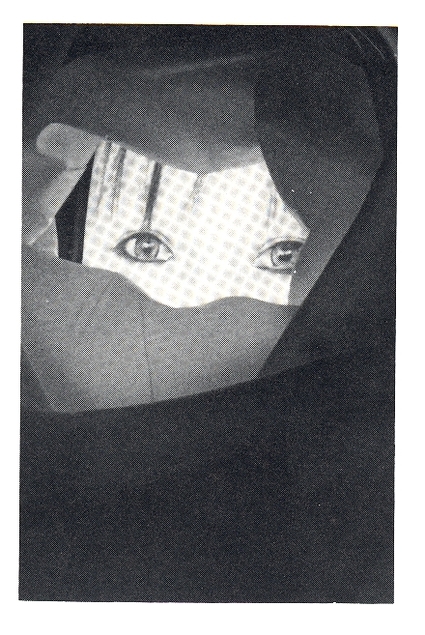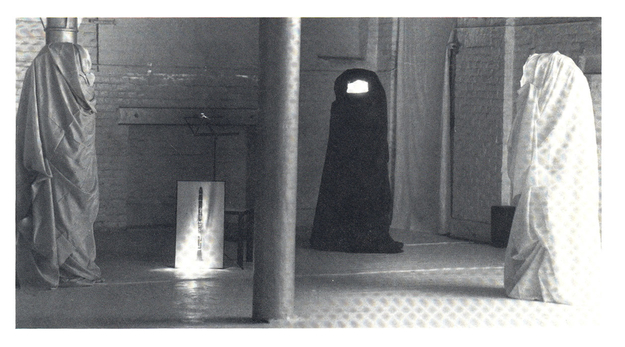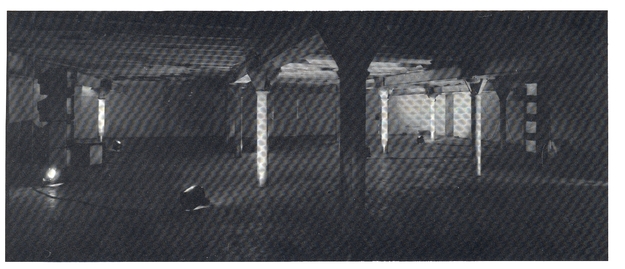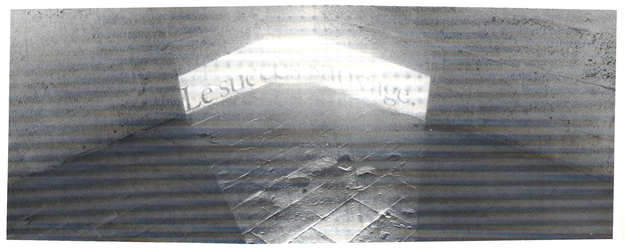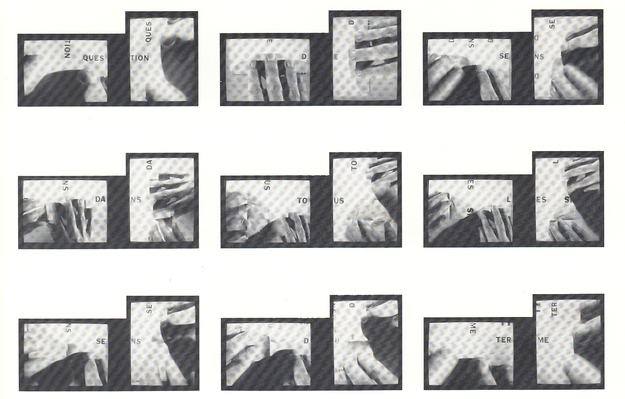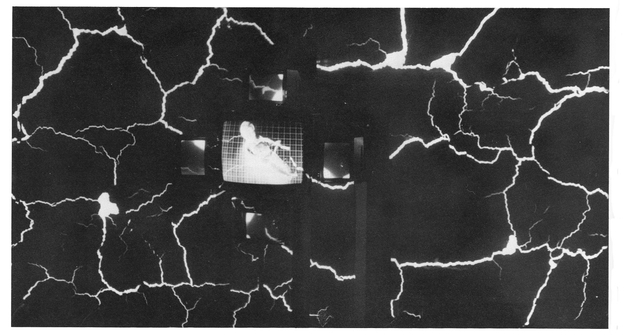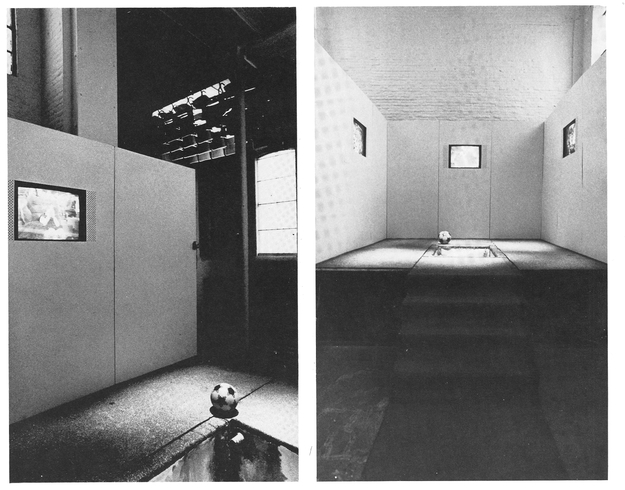Jacques Louis Nyst
Les Chemins de Fer
Three monitors standing around the edges of a small hole in a concrete ceiling. All three monitors showed the image of an iron, rosette-shaped ventilation grill, There was the sound of a musical box as an invisible hand/force opened the grill. At the same time, the light from our side of the grill (inside) shifted outside. Pale daylight shone in through the openings and a few branches were visible. When the grill closed, the musical box stopped and the artificial light shone on our side once more. The bright paintwork became visible again. Some seconds later it opened again and everything was repeated.
This resulted in a pleasing rhythm of opening/closing, breathing in/breathing out, day/night, inside/outside, dead/alive, speaking/remaining silent, out/at home. Beautiful, with a poetic lightness. But after a short time, the sound of the musical box became unbearable and it was impossible to enjoy the still beautiful image anymore.
Marie Delier
Femmes Voilees
Approaching MARIE DELIER's installation you were caught in the gaze of three veiled women standing around a music stand and a stool. There was some music on the stand, next to it the instrument of a clarinettist who could have returned at any moment.
Three pairs of eyes were looking at you. You felt uncomfortable, stared at. The same feeling as entering a cafe on your own or visiting a reception. Everyone seems to be watching you. You couldn't lose that feeling even when you realized that they were not real women looking at you but images on a monitor. You were an intruder.
Now and then you could hear fumbling clarinet music. The three women were talking. Each one had unmistakably her own voice although their mouths were not visible behind their veils. They murmured in unintelligible French. It didn't look like a conversation, it was even uncertain whether they could hear each other.
The women's gazes, which were made more intense by their veils, and the voices passing you created a great distance between you and the women, despite the eye contact. Their clear presence was at the same time their absence. They were images you couldn't respond to. Letters in bottles. You were being looked at but looking back didn't help. The empty stool with the clarinet and music stand also added to this lonely feeling.
The clarinet music with its attributes so very present, emphasized the performer's absence. During the exhibition's opening, the musician was present. He played the clarinet sitting on the stool and read the music from the score. But as soon as more than three or four people came to listen, he put the clarinet on the ground and disappeared. When the spectators moved on, he returned until... and so on and so forth.
The tension between presence and the unattainable, between reality and longing, looking and seeing, distance and closeness gives MARIE DELIER's installation a melancholy beauty.
Gerald Minkoff/ Muriel Olesen
Caryatides in situ
ou Samson fait la différence,
Dalton s'en balance
A broad, deep warehouse space. The low ceiling supported by cast-iron pillars. The only lighting was created by spotlights which cast a red glow across the pillars in the center. The golden coating on the underside of the pillars was just visible in the monochrome light.
In the space, there was a column of four monitors to both the left and the right. A fifth column was lying on its side next to each column. These ensembles stood with their screens facing each other.
On the monitors was a static blue-green abstract image. The blue-green color had a very special vibrating, intangible quality. The images seemed like echoes on the retina in their contrast with the red light that filled the space. The monitors didn't seem to project any light despite the low light level in the space, rather the green glow remained within the equipment.
In front of the space to the left and in the back to the right was a small chipboard house on a swing. Lenses protruded from door openings in the houses. The houses looked out towards the pillars. On closer inspection, the monitor images appeared to have originated from these houses. Two closed circuits with electronically modified colors. The blue-green images gave the hall sort of imernal bulges, electronic entrails. In the video, it had, as it were, turned itself inside out. Through that, it had become even more inaccessible, intangible in its red glow. The concrete space and the video image had been reversed.
Meanwhile, there were points of contact between the two worlds: the houses completely motionless on their swings. We thought of giving the swings a little push but didn't risk it. That would have completely destroyed the space. Back in Groningen, we read in the catalogue that that was exactly what we supposed to do. Perhaps we would have dared to do it had we been color blind.
Antoni Muntadas
Derrière les Mots
Le Gout de l'aventure
Le succès sauvage
ècoutez l'image
Pour le plaisir des yeux
MUNTADAS was responsible for the commercial breaks. He positioned video monitors and slide projectors at the transition points between different spaces, between different installations. Each set of equipment presented a slogan borrowed from advertising, Right at the back of the exhibition was a monitor on which a number of these texts alternated with each other. Enlarged to fill the screen, the keywords of each slogan were repeated. RAY CONNIFF music underlined the hollowness of the image.
The circulated texts were blown up beyond their power by their museum-like presentation and isolation from their original context. They gained a monumental beauty which they could not support. They attempted Münchhausen-style to pull themselves out of the swamp of triviality by their own wigs, each time to sink back in again.
Unfortunately, the last monitor was much less dramatic. The succession of various texts and the instantly banal music made MUNTADAS' statement too one-dimensional. It lost its allure and became moralist in flavour. The horse that VON MüNCHHAUSEN gripped between his thighs here seemed to be a squeaky little toy.
Bernard Queeckers
Un Question de Sens dans tous les Sens du Terme
Un = a
Question = question, matter, torture
de = of, about, until, to, out, on
Sens = sense, the senses, feeling, meaning, attitude, view, persuasion, orientation, understanding
dans = in, out, over, during, with, by, under
taus = all, entire, all together
les = the
du = see: de
Terme = term, expression, word, limit, goal, outcome
Carlos da Ponte
Sans Titre
The explosion of the American space shuttle on 28 January 1986 is the ultimate Eighties media disaster. The images circled the world at least as quickly as those of KENNEDY's murder. Whereas the disaster in the Sixties had the quality of a short thriller in the Nouvelle Vague style, the Eighties disaster had the format of a visually perfect 30 seconds commercial. The President's murder returned in video art over the following decade. ANT FARM even made a complete remake (The Eternal Frame 1975). Within just one year, the rocket's explosion has already appeared in the work of a number of media artists (two in this issue). It would be interesting to organize an exhibition in 1990 of art videos that deal with that image.
CARLOS DA PONTE also used it in his extremely aesthetic installation for PLAN K: a large monitor surrounded by four small ones created a cross shape. Both explosion and cross were component parts of a mosaic of sometimes distinguishable, sometimes overlapping signs. Not simply in the semiotic sense but more directly as means of construction employed within the work.
There were images of a baby on the central monitor, blankly looking in or past the lens, Tabula Rasa. The infant was lying on unused squared graph paper suggesting neutrality.
The four small monitors were placed with their bases against the large screen so that they create a point-symmetrical image that encircled the baby like a wreath. Using this device, DA PONTE enacted a subtle game: moving a white surface over the image resulted in a movement in four directions in the installation, the wreath image rotated. The suggestion of movement was varied and alternated with stationary images, large figures resulting from the fourfold multiplication of the small image. The arrangement became a hypnotizing semaphore, a vibrating signal.
Periodically, the signaling device supplied a different image; the skyline of a city, the most complicated, multi-level sign system that continuously surrounds and besieges us, and the exploding space-shuttle, the most simple ominous sign created by the Eighties. The third non-geometric image was that of a man who nodded his head manically as he wanted, in vain, to shake off all images. He appeared briefly, afterwards the cross hurtled past once more.
A crackle was projected over the monitors and the wall behind them. Like a cosmos, a sea of time. This script in time forms a contrast with the young baby on the middle monitor. At the same time, through his pristine quality, the child was still part of the infinite. The wreath sign simply fixed it in time and space.
Koen Theys
Sirenes
When ODYSSEUS was sailing to Circe, he had to pass the island where the SIRENS lived. These half woman/half bird creatures were endowed with bewitching voices. They would entice passing sailors who were then smashed against the rocks. ODYSSEUS had been warned of the danger. He stopped up the ears of the crew with wax and he had himself tied to the mast of his ship. Thus, he succeeded in being the only man to hear the SIREN's song without paying for it with his life.
Myth and morality seem to have inspired KOEN THEYS to make this installation. In a high, square space, a carpet and the sound of applause invited the visitor to walk up the stairs and onto a podium. The podium was surrounded by three walls. There was a monitor at eye-level on each wall showing an audience applauding. The image on the monitor of he middle wall was the wrong way up. Visually, this related to five rows of folding chairs that were attached upside down to the ceiling.
The audience on the monitor looked at whoever came up the stairs. As an extension of the stairs, there was a rectangular pool full of water set into the podium. A ball floated on the water. If you got too carried away by the applause and felt as if your head was in the clouds there was a real chance of not looking where you were going and of falling in the pool. Like a toy ball in the hands of the audience. But if you remained alert to enticement then you would see a button on the left-hand wall. If you pressed it, an outboard motor was turned on which had its exhaust pipe in the pool. This caused a wash. It was as if a boat was speeding in the direction of the empty chairs.
Just in time (the artist) escaped from the enticement of applause.
If you'd like to quote something: Possel Jans, and Willem Velthoven. "7 Installations Video à Bruxelles." Mediamatic Magazine vol. 1 # 4 (1987).
Translation: Annie Wright
